#USS FLORIDA (BB-30)
Explore tagged Tumblr posts
Text

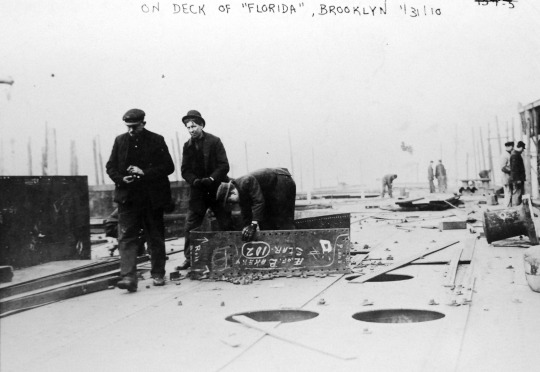
Yard workers walking the deck of USS FLORIDA (BB-30), at the New York Navy Yard.
Photographed on January 31, 1910.
George Bain Collection.
Library of Congress: Lot-10777-3, Lot-10777-4
#USS FLORIDA (BB-30)#USS FLORIDA#Florida Class#Dreadnought#Battleship#Warship#Ship#United States Navy#U.S. Navy#US Navy#USN#Navy#New York Shipbuilding Corporation#New York Ship#Camden#New Jersey#East Coast#Delaware River#construction#January#1910#my post
21 notes
·
View notes
Photo
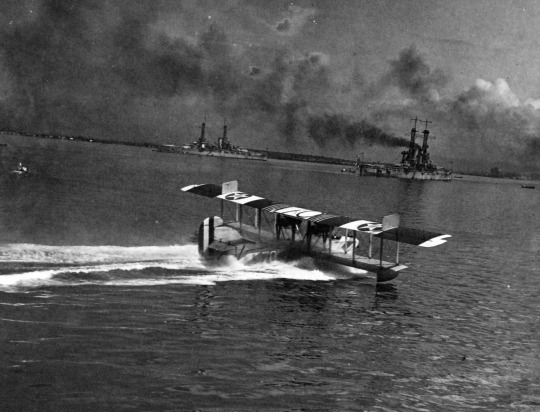
An F5L prepares to take off in support of naval gunfire practice, 15 March 1921. In the background are USS Florida (BB-30) and USS Oklahoma (BB-37)
137 notes
·
View notes
Photo

Named US Military Medals Mexico USS Florida BB-30 Battleship Navy War College Be quick $495.00 https://ebay.to/2LcqBJ1
0 notes
Text
George Fried - Wikipedia
This article is about the US sea captain. For the British footballer of subtly different spelling, see
George Friend
.
George Fried, (August 10, 1877 – July 25, 1949) a sea Captain with service in both the US Navy and Merchant Marine, is best remembered for his valiant rescue of the crews of the British steamship Antinoe in 1926 while captaining the luxury liner SS President Roosevelt and three years later the Italian freighter Florida while in command of the luxury liner USS America. Both of the ships he captained during the rescues were owned by the large United States Lines. Fried became familiar to thousands of Americans when his syndicated column "My Thirty Years at Sea", which chronicled his life and ocean adventures, was featured in major newspapers beginning in 1929.
Early life
Fried was born in Worcester, Massachusetts, on August 10, 1877, and attended the Belmont and Dix Street Schools. He worked on a local farm from ages twelve to fifteen, harvesting beets and corn, but from an early age had a desire to sail the seas.[1][2] He entered Army service at the age of twenty-one during the period of the Spanish–American War and served from 1898 to 1900.[3]
Early Naval career
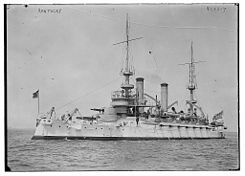
USS
Kentucky
circa 1905–08
After his brief stint with the Army, Fried enlisted in the U.S. Navy in 1900 in New York. His first naval assignment was with the historic USS Hartford, a 255-foot steam and sail-powered sloop of war, which had seen service in the Civil War. As a fledgling US Naval seaman, he began service swabbing the Hartford's decks, working the coalroom, and trimming sails.
During many of the summers from 1900–12, the Hartford took US Naval Academy midshipmen on a cruise to gain hands on experience with essential seafaring skills. During several of these cruises, Fried worked in the deck area where navigation was being taught. In his spare time, he began to study navigational formulas and was assisted by officers, until he had begun to grasp the fundamentals of the science of navigation. During five years of service aboard the Hartford from 1900–05, he progressed from ordinary seaman to coxswain, quartermaster, and finally chief quartermaster, with each position developing and refining what would become his remarkable navigation skills.[4]
In 1916, after short rotations aboard various cruisers and battleships, Fried became third officer aboard the USS Solace (AH-2) as a member of the Merchant Marines. Solace was a 377-foot hospital ship and part of the Atlantic fleet.[5]
After serving on the Solace, he was recalled by the Navy and became an ensign in the North Atlantic aboard the pre-dreadnought battleship USS Kentucky (BB-6).[6] Fried served with the Navy between 1916 and 1921 and reached the rank of Lieutenant (junior grade)[7] aboard the USS Petrel, a 188-foot gunboat. At the outbreak of World War I, Fried was promoted to full Lieutenant and placed in charge of the cargo ship USS Zuiderdijk as she carried supplies from New York to France.
Mid-career and historic rescues

SS
President Roosevelt
, 1920s
Fried's service with the United States Lines after 1921 was as a member of the Merchant Marine. He served as chief officer on the United States Lines' luxury liner SS President Grant and briefly in this position as well on the USS America. He married Laura Parmenter on March 21, 1922 in New York.
In 1922, Fried was promoted to the captaincy of the luxury liner SS President Roosevelt.[3] On January 20, 1926, with Fried as captain, Roosevelt received an SOS from the British steam cargo ship Antinoe. After several attempts amidst violent snowstorms and rough seas, Roosevelt succeeded in rescuing her crew of twenty-five on midnight of the following day. The rescue was made memorable by the Roosevelt's persistence in remaining with the sinking Antinoe despite rough seas, snow, and bitter cold. After completing the rescue of her crew, Roosevelt left the listing, damaged Antinoe abandoned with no electrical power. On her return to Hoboken Pier, Roosevelt was greeted by local dignitaries, including New Jersey Governor Harry Moore, who gave an address. Roosevelt's officers and crew were entertained by a band, received a twenty-one-gun salute, and were welcomed to New York by Mayor Jimmy Walker, after a stay at the Roosevelt Hotel and a ticker-tape parade. For his heroic efforts, Fried was awarded the Navy Cross and both he and members of the Roosevelt's crew were decorated by the British government.[3][8]
Fried took command of the SS America in 1928. Only three years after his previous rescue, while serving as captain of the SS America, Fried rescued the thirty-two man crew of the Italian steamship Florida in freezing weather and violent snow squalls. America was heading to New York from France. As she battled her way through a major storm, the liner picked up distress signals from Florida. Navigating with the aid of a radio direction finder, the America fixed a location on the Italian ship, and late the following afternoon on January 28, 1929, sighted the endangered vessel.
Pulling alongside of Florida's weather beam, America launched a lifeboat, commanded by her chief officer, Harry Manning, with an eight-man crew. Manning's crew rowed the lifeboat to within fifty feet of the listing Florida, and a line was thrown to the frantic crew of the freighter. One by one, men from the Italian ship came across the rope. By the time the Florida's captain had been pulled on board the lifeboat as the last man, winds were gale force, and the seas were rough and high. After rowing the lifeboat back to the America, her sailors helped haul aboard the survivors of the Florida using ladders, ropes, cargo nets, and two homemade breeches buoy. The breeches buoys were basically zip lines tied from America's large life raft containing the rescued crew of the Florida to the waiting America. Fried became a national hero when his account of the story was widely distributed by newspapers.[9][10]
In 1931, Fried rescued Lew Aichers when his plane crashed fifteen miles off the coast of Ireland. On November 30, 1931, Fried took command of the United States Lines' SS Manhattan, launched from Camden, New Jersey. She was a 705-foot long, 30,000-ton merchantman. During his career with United States Lines, Fried also captained the SS Leviathan for three trips during the illness of her Captain A. B. Randall.[3]
With his exceptional career well established, Fried commanded the luxury ocean liner SS Washington, first launched on August 20, 1932. She would become the flag ship of the United States Lines from 1934–40.
Retirement
After nearly half a century with the Navy and Merchant Marine, George Fried retired in 1946.[9] In retirement, he enjoyed reading, gardening, and spending time with his wife Laura. He died in Yonkers, New York on July 25, 1949,[11] and was buried at Mount Hope Cemetery at Hastings-on-Hudson, New York.[2]
References
^ Fried, George, "My Thirty Years at Sea", Prescott Evening Courier, pg. 3, Prescott, Arizona, 25 February 1929.
^ a b "Captain George Fried". Find-a-grave. Retrieved 18 April 2015.
^ a b c d "Hero of Many Sea Rescues Will Get Coveted Position as Commander of Big Ship", The Evening-Independent, pg. 18, St. Petersburg, Florida , 30 November 1931.
^ Fried, George, "My Thirty Years at Sea", Ludington Daily News, pg. 5, Ludington, Michigan, 26 February 1929.
^ Fried, George, "My Thirty Years at Sea", Prescott Evening Courier, pg. 5, Prescott, Arizona, 6 March 1929.
^ Navy Departiment, United States (1968). Dictionary of American Fighting Ships, vol. 3. Washington DC: Government Printing Office. pp. 626–628.
^ Navy Department, United States (1918). "Navy Directory". Navy Directory:Officers of the United States Navy. July 1: 80.
^ Fried, George, "Nation Opens Arms to Captain and Crew of America", Herald-Journal, pg. 1, Spartanburg, South Carolina, 15 February 1926.
^ a b Poling, Dr. Daniel A., "Salute to George Fried-Sea Captain", Herald-Journal, pg. 4, Spartanburg, South Carolina, 31 August 1946.
^ Knight, Austin M., Modern Seamanship (1930), D. Van Nostrand Company Inc., pgs. 802–05.
^ "In a Sleety Gale, Captain George Fried Accomplished His most Memorable Rescue", The Milwaukee Sentinel, pg. 30, Milwaukee, Wisconsin, 16 April 1950
External links
0 notes
Photo
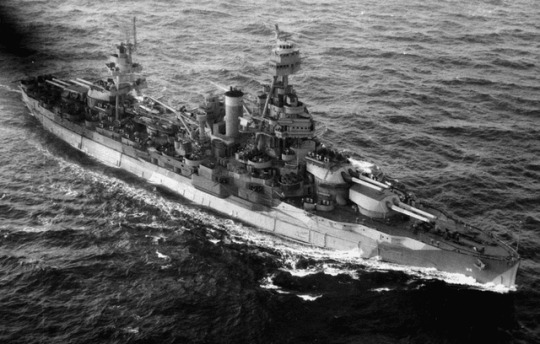
Tracing its origins to the 1908 Newport Conference, the New York-class of battleships was the US Navy's fifth type of dreadnought after the South Carolina- (BB-26/27), Delaware- (BB-28/29), Florida- (BB-30/31) Wyoming-classes (BB-32/33). Central among the conference's findings was the requirement for ever larger calibers of main guns as foreign navies had begun using 13.5" guns. Though discussions commenced regarding the armament of the Florida- and Wyoming-class ships, their construction advanced using the standard 12" guns. Complicating the debate was the fact that no US dreadnought had entered service and designs were based on theory, war games, and experience with pre-dreadnought ships. In 1909, the General Board pushed forward designs for a battleship mounting 14" guns. Named USS New York (BB-34) and USS Texas (BB-35), the new ships mounted ten 14" guns in five twin turrets. These were situated with two forward and two aft in superfiring arrangements while the fifth turret was placed amidships. The secondary battery consisted of twenty-one 5" guns and four 21" torpedo tubes. The tubes were situated with two in the bow and two in the stern. No anti-aircraft guns were included in the initial design, but the rise of naval aviation saw the addition two 3" guns in 1916. Propulsion for the New York-class ships came from fourteen Babcock & Wilcox coal-fired boilers powering dual-acting, vertical triple expansion steam engines. These turned two propellers and gave the vessels a speed of 21 knots. The New York-class was the last class of battleships designed for the US Navy to utilize coal for fuel. Protection for the ships came from a 12" main armor belt with 6.5" covering the vessels' casemates.
0 notes
Text
USS Arkansas, dos guerras mundiales y dos bombas atómicas
USS Arkansas, dos guerras mundiales y dos bombas atómicas

A las nueve y media de la mañana del día 25 de junio de 1929 y tras efectuar el saludo al cañón desde el buque insignia, efectuaba la entrada al puerto de Barcelona una escuadra norteamericana de acorazados dreadnought compuesta los el USS Arkansas BB-33, USS Utah BB-31 y el USS Florida BB-30 al mando del almirante Harris Laning, en viaje de instrucción por aguas inglesas y del Mar Mediterráneo.…
View On WordPress
0 notes
Text
Florida’s Underwater Archaeological Preserves: USS Massachusetts (BB-2)
Florida’s Underwater Archaeological Preserves form a heritage diving trail, made up of 12 historically significant shipwrecks from different time periods. San Pedro wrecked in 1733; SS Copenhagen wrecked in 1900; and Vamar wrecked in 1942, for example. A member of the public nominates potential preserves, which must be easily accessible, host a variety of sea life, and have recognizable and interesting features. After they become preserves, a variety brochures, underwater plaques, and the website help explain the wreck’s history. Preserves are popular with both skin- and scuba divers.
History of the USS Massachusetts
USS Massachusetts sheds light on a lesser-known aspect of Florida’s history: The Spanish-American War. The USS Massachusetts was one of the three most powerful heavy-caliber and armored Indiana class vessels of the time, and part of the newly formed United States “Steel Navy.” It was a pre-dreadnaught type battleship, which were built between 1880 and 1905. These ships were built after older and outdated ironclads, but before heavier battleships featuring long-range guns.
William Cramp and Sons of Philadelphia built the USS Massachusetts in 1891. It was 350 feet long (107 m) with a 69-foot (21 m) beam and a draft of 24 feet (7 m). The battleship had almost 10,000 horsepower, allowing it to reach a 15-knot cruising speed. Heavily armed, the Massachusetts carried two 13-inch guns forward and aft and four 8-inch secondary batteries, mounted amidships. The ship also contained four torpedo tubes and a variety of small arms.
Launched in 1893, the ship saw battle during the Spanish-American War in 1898, serving as part of the blockade of Cuba. On May 31 near the port of Santiago, USS Massachusetts, along with battleships Iowa and New Orleans, exchanged fire with Cristóbal Colón, forcing the Spanish cruiser to retire into the inner harbor. USS Massachusetts also ran Reina Mercedes aground before traveling to Puerto Rico in support of the occupation.
After the war
After the Spanish-American War, the battleship continued to serve with the North Atlantic Squadron. In 1903, off Culebra, Puerto Rico, target practice resulted in a premature detonation of one of the 8-inch turrets, causing the death of nine sailors. In 1910, the Massachusetts became a training ship for midshipmen. The Navy decommissioned the ship in 1914.
During World War I in 1917, it was recommissioned for naval gunnery crew training before its final decommission in 1919. The War Department scuttled the ship in 1921 off the coast of Pensacola to be used as a target ship for artillery fire. The wreck has been bombarded with railguns and experimental artillery, and divers attempting to remove lead ballast from the gun turrets reportedly dynamited the wreck in the 1950s. The explosions collapsed the upper decks, causing the turrets to tilt inward and dislodge the four 8-inch gun turrets from their mountings.
In 1956, various companies attempted to salvage USS Massachusetts, but Pensacola’s fishing community moved to stop the work; the battleship had become a popular fishing platform. The case against its salvage went all the way to the Supreme Court, and the site ultimately became the property of the State of Florida. In 1990, a Pensacola diver nominated it as the fourth Underwater Archaeological Preserve. The site was dedicated in 1993, on the centennial of its launching. It joined the National Register of Historic Places in 2001.
Diving the USS Massachusetts
Today, the marine-encrusted battleship rests quietly on the white sands of the Gulf of Mexico. It’s 1.5 miles south/southwest of Pensacola Pass. A bronze plaque designating the wreck as an Underwater Archaeological Preserve marks the spot. Due to the shallow depth (26 to 30 feet), the turrets rise close to the surface and at times are awash. Artillery fire and general deterioration have exposed various features, providing divers the opportunity to witness the battleship’s internal mechanisms. The patient diver may identify turrets, turret covers, ammunition tubes, cupolas, boiler-hatch covers, the anchor chain, and the fighting top.
After 96 years on the ocean bottom, the wreck is a refuge for Gulf marine life, acting as an artificial reef in Fort Pickens Aquatic Preserve. Divers can expect to see mollusks, crustaceans, various fish, sponges, soft corals, and turtles. Eileen Beard, owner of Scuba Shack in Pensacola, has been diving the wreck for years.
“When the conditions are right the wreck really is one of the most beautiful dives to make,” she says. “It has been down for so long that it has a complete ecosystem. Once we saw seven goliath groupers. The ecosystem never ceases to amaze me.”
When to dive the site
Beard stresses the importance of diving USS Massachusetts at the appropriate time: slack high tide. The nearby pass affects currents and visibility, and diving at an unsuitable time can cause low visibility and strong surge. Visitors should also use caution when navigating to the wreck, which comes right up to the surface. Interested divers can obtain a laminated map from local dive shops to help orient themselves on the shipwreck.
By guest author Melissa R. Price
The post Florida’s Underwater Archaeological Preserves: USS Massachusetts (BB-2) appeared first on Scuba Diver Life.
from Scuba Diver Life http://ift.tt/2tvKVgj
0 notes
Text

USS TEXAS (BB-35) at the New York Navy Yard, on December 30, 1914. She had returned the New York Navy Yard on December 28 after conducting soundings off the eastern coast.
Note: the sign in the foreground for USS FLORIDA (BB-30) (possibly she just left or is out of frame) and USS CUMMINS (DD-44). There are Christmas trees in her mast.
Special thanks to Evan Dwyer for cleaning up this photo. Information provided by Travis Davis from the Battleship Texas Foundation.
source
#USS Texas (BB-35)#USS Texas#New York Class#Battleship#Battleship Texas#Dreadnought#warship#ship#December#1914#east coast#New York City#New York Navy Yard#New York#Brooklyn#united states navy#us navy#navy#usn#u.s. navy#USS Cummins (DD-44)#USS Cummins#Cassin Class#Destroyer#my post
37 notes
·
View notes
Photo

The beginning of USS Delaware (BB-28) being scrapped. USS Florida (BB-30) is to the left. http://ift.tt/2rCjKyZ
0 notes
Photo

USS Florida (BB-30) prepares to launch a Loening OL amphibian from her #3 turret catapult, 1927-1931
56 notes
·
View notes
Text
Battleship Squadron Leaves For Mexico, 1914

A newspaper photograph of Atlantic Fleet battleships deploying from Hampton Roads to Mexico, April 15, 1914. It should be noted that the newspaper's caption have the wrong ship names.
"One hundred years ago yesterday, acting on instructions from President Woodrow Wilson, Secretary of the Navy Josephus Daniels ordered the Hampton Roads-based ships of the Atlantic Fleet to mobilize and head to the east coast of Mexico. The first squadron to deploy included the new battleships USS Arkansas (BB-33), USS Utah (BB-31), and Florida (BB-30); the older battleships USS New Jersey (BB-16) and USS New Hampshire (BB-25); and the dispatch boat/armed yacht USS Yankton. Daniels had specifically ordered the squadron to Tampico and Vera Cruz. Daniels deployed the squadron of heavy ships to reinforce a smaller squadron already on the scene.
The deployment of American battleships came from a culmination of a series of international incidents. A few days before, Mexican authorities had arrested several American sailors in Tampico, and later a Marine who got lost while trying to deliver official mail. These arrests occurred during the latest civil war in Mexico. There was also an American belief that European powers were attempting to intervene in the war. Thus, tensions between Mexico and the United States were high.
Mexican authorities agreed to release the American servicemen, but some senior U.S. Naval officers, and later President Wilson himself, beleived American honor had been insulted. They demanded official apology and a 21-gun salute to the American flag by the Mexican government. When the Mexican reply to the American demands was not forthcoming quickly enough, Wilson put the Navy's ships on alert.
While Assistant Secretary of the Navy Franklin Roosevelt commented to the press that the Navy was prepared for anything, there is evidence that the mobilization order caught the Atlantic Fleet somewhat off guard. Several of the ships were not prepared for an extended deployment. New Hampshire's sailors, for example, worked through the night and early morning of April 15 loading 1,600 tons of coal on board. The Navy quickly called up all sailors stationed at St. Helena Naval Training Station and on board the local receiving ships Franklin and Richmond, regardless of rate, sea experience, or enlistment status, to fill in personnel gaps. Many other ships in the Atlantic Fleet were not ready, including the battleships Texas (BB-35) and Delaware (BB-28) and several repair vessels and coal colliers.
Even though the initial operation was only a partial mobilization of the Atlantic Fleet, the five battleships' deployment raised American jingoism to a fever pitch. Most Americans fully supported the deployment and even offered to help in their own special way. The Governor of Texas, for example, offered to invade Mexico on behalf of the United States. The President politely declined."
Article by the Hampton Roads Naval Museum: link
13 notes
·
View notes
Text






USS FLORIDA (BB-30) under construction at the New York Navy Yard. It looks like the turrets are finished and the super structure is being worked on, with the scaffolding around the boat crane post(aka kingposts or derricks).
Photos are part of the George Bain Collection.
Photographed on January 18, 1911.
Library of Congress: LC-B2- 2135-6, LC-B2- 2135-7, LC-B2- 2135-8, LC-B2- 2135-9, LC-B2- 2135-10, LC-B2- 2135-10a
#USS Florida (BB-30)#USS Florida#Florida Class#dreadnought#battleship#warship#ship#ship construction#January#1911#New York Navy Yard#New York#East coast#Brooklyn#united states navy#us navy#navy#usn#u.s. navy#my post
118 notes
·
View notes
Text

A Curtiss JN "Jenny" flying over USS FLORIDA (BB-30) anchored in the Hudson River, New York.
Photographed on December 31, 1918.
NARA: 45512475
#USS Florida (BB-30)#USS Florida#Florida Class#Battleship#dreadnought#warship#ship#Curtiss JN#Curtiss JN Jenny#JN#Aircraft#united states navy#us navy#navy#usn#u.s. navy#December#1918#interwar period#Hudson River#North River#New York City#New York#my post
112 notes
·
View notes
Text
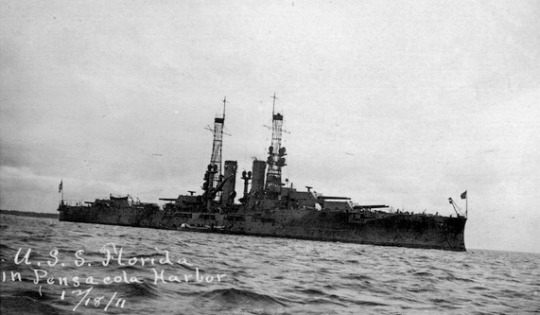
USS FLORIDA (BB-30) in Pensacola Harbor, Florida.
Photographed on December 18, 1911.
State Library and Archives of Florida: PC3286, N040571
#USS Florida (BB-30)#USS Florida#Florida Class#Battleship#dreadnought#warship#ship#Pensacola#Florida#December#1911#united states navy#us navy#navy#usn#u.s. navy#my post
62 notes
·
View notes
Text

USS FLORIDA (BB-30) in the middle of modernization in the Boston Navy Yard, Massachusetts.
Photographed sometime between 1925 and 1927.
Boston Public Library: 08_06_004737
#USS Florida (BB-30)#USS Florida#Florida Class#dreadnought#battleship#warship#ship#modernization#1925#1927#undated#interwar period#Boston Navy Yard#Boston#Massachusetts#east coast#united states navy#usn#navy#u.s. navy#us navy#my post
64 notes
·
View notes
